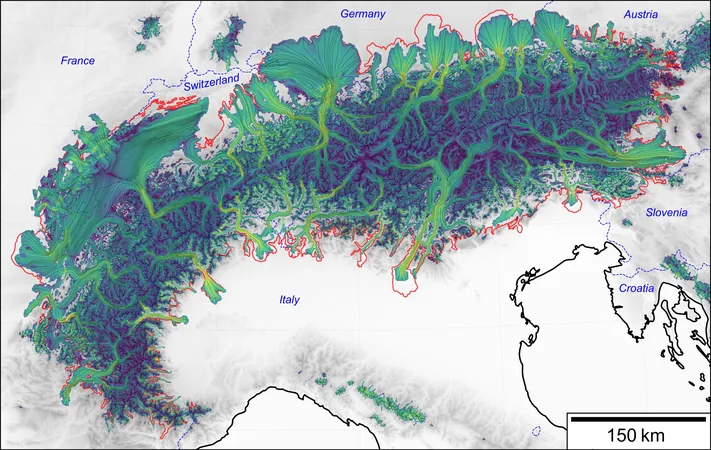
How AI is Revolutionizing Glacier Modeling and Transforming Our Understanding of the Alps' Ice Age
2025-01-22
Author: Sarah
Introduction
In a groundbreaking study, scientists at the University of Lausanne (UNIL) have harnessed the power of artificial intelligence to dramatically enhance the accuracy of glacier modeling. This innovative approach allows for unprecedented simulations of the last ice cover in the Alps, revealing that the ice was significantly thinner than previously thought. The findings, published in Nature Communications, could reshape how we understand climate change and its effects on our planet.
Historical Context
Around 25,000 years ago, the Alps were enveloped by ice layers that reached thicknesses up to 2 kilometers. For more than a decade, researchers have utilized 3D digital modeling techniques, which integrate climate reconstruction data, thermodynamics, and ice physics to understand glacial evolution. However, these early models faced criticism and confusion within the scientific community due to inconsistencies observed in field evidence—such as erosion lines and moraines—that documented the history of ice thickness.
AI-Enhanced Modeling
Now, UNIL's team has successfully addressed these discrepancies by employing artificial intelligence, which enhances their glacial evolution model. This methodology generates a substantial series of simulations with remarkable accuracy, aligning closely with geological evidence. Their results indicate an average ice cover that is 35-50% thinner than previous simulations, resolving long-standing debates among scientists.
Precision and Detail
The precision of this new model is noteworthy; it narrows the resolution from two kilometers down to an astonishing 300 meters. This leap in detail allows for an accurate representation of the Alps' complex topography. Notably, the research demonstrates that well-known peaks, such as the Matterhorn and Grand Muveran, were above the ice during the Ice Age, which contradicts earlier beliefs.
Broader Implications
The implications of this study are profound. Understanding historical glaciation is crucial for comprehending current environmental conditions. For the past 2 million years, our planet has oscillated between glacial and temperate phases, each cycle significantly sculpting the landscape we inhabit today.
Technological Breakthrough
However, the impact of this research extends beyond just glacier modeling; it heralds a new approach to numerical modeling altogether. “Using modern technology to analyze the last major glaciation in the Alps enables us to run a 17,000-year simulation at high resolution in just 2.5 days. Traditional methods required 2.5 years to complete similar tasks, not to mention their energy and resource intensity,” says Tancrède Leger, a researcher at UNIL’s Faculty of Geosciences and Environment (FGSE) and the study's lead author.
The method employs deep learning techniques, initially training on the physical dynamics of ice flow. It then integrates climatic data to accurately simulate ice accumulation and melting. Remarkably, these computations are executed using graphics processing units (GPUs) rather than conventional central processing units (CPUs), allowing for more efficient parallel processing and dramatically improving computational power.
The Future of AI in Environmental Science
“It’s like upgrading from having six Ferraris to deploying ten thousand compact cars,” explains Guillaume Jouvet, a professor at FGSE and co-author of the study. “The essence of our work remains unchanged, but the speed at which we can achieve results is astonishingly faster, unlocking resolutions that were once deemed unfeasible.”
This significant advancement signals the beginning of a plethora of new research opportunities. A forthcoming project aims to leverage this revolutionary modeling method to predict the effects of melting ice sheets in Greenland and Antarctica on global sea level rise—a pressing concern amidst the escalating impacts of climate change.
As this research progresses, it could lead to critical insights that help us prepare for the consequences of a warming world, making it vital for both scientific exploration and public awareness. The potential of AI in environmental science is just beginning to be unlocked, and the future promises more revelations that could define our understanding of Earth's intricate climate history.







 Brasil (PT)
Brasil (PT)
 Canada (EN)
Canada (EN)
 Chile (ES)
Chile (ES)
 Česko (CS)
Česko (CS)
 대한민국 (KO)
대한민국 (KO)
 España (ES)
España (ES)
 France (FR)
France (FR)
 Hong Kong (EN)
Hong Kong (EN)
 Italia (IT)
Italia (IT)
 日本 (JA)
日本 (JA)
 Magyarország (HU)
Magyarország (HU)
 Norge (NO)
Norge (NO)
 Polska (PL)
Polska (PL)
 Schweiz (DE)
Schweiz (DE)
 Singapore (EN)
Singapore (EN)
 Sverige (SV)
Sverige (SV)
 Suomi (FI)
Suomi (FI)
 Türkiye (TR)
Türkiye (TR)
 الإمارات العربية المتحدة (AR)
الإمارات العربية المتحدة (AR)